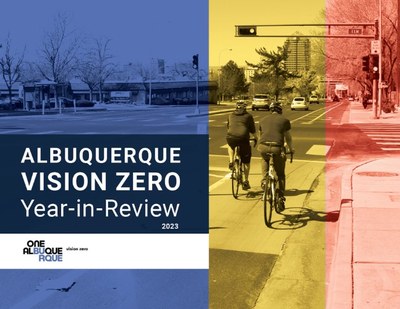What is Vision Zero
Information about the City's actions to improve traffic safety in Albuquerque.
What is an acceptable number of traffic deaths for my family?
ZERO.
Vision Zero starts with an ethical belief that no one should die or be seriously injured on our roadways. We cannot prevent collisions from happening but when a collision does occur, the City is working toward making sure it does not result in death or serious injury. Vision Zero uses a data-driven and safe systems approach to create safer streets for everyone - whether we're walking, biking, driving, or taking transit, and regardless of age or ability. It is used around the world to eliminate all traffic fatalities and serious injuries while increasing safe, healthy, equitable mobility for all. Read more about Vision Zero.
Based on preliminary 2022 crash data, at least 66 people were killed while traveling around our city. That is 66 too many of our family members, children, friends, and neighbors. We can all take steps to improve safety on Albuquerque streets.
Vision Zero in ABQ The Data Who is Involved? The Data Safety Improvements

The City completed an update to the Vision Zero Action Plan called the Year-in-Review for 2023 (YIR), approved at City Council in November 2023. The YIR assessed progress made toward Vision Zero, including projects and programs that have been successful and also identifying which ones needed to be adjusted. The YIR ultimately prioritizes thematic goals, actions, and corridors where the City should first focus on traffic safety efforts to have the greatest impact in reducing and eliminating traffic deaths and serious injuries by 2040. It also replaces the 2021 Action Plan for the City to implement Vision Zero efforts. Read the Vision Zero 2023 Year-in-Review/Action Plan Update.
In May 2021, the City of Albuquerque released its Vision Zero Action, which lays out steps that the City, working with agency and community partners, will take to reduce traffic fatalities and make our streets safer. Read the 2021 Vision Zero Action Plan.
In May 2019, Mayor Keller made a commitment to Vision Zero and signed an Executive Order committing the City of Albuquerque to work toward the goal of zero traffic deaths by 2040. View the Executive Order.
Data-driven decision-making is a key element of any Vision Zero effort. In order to solve traffic safety problems in our community, we need to better understand the causes. This is some of the data that we use to help guide our work:
- View the City of Albuquerque’s Prioritized High Fatal and Injury Network (HFIN) and information about projects with traffic safety elements.
- View the Mid-Region Metropolitan Planning Organization (MRMPO) Regional High Fatal and Injury Network and read the 2024 Regional Transportation Safety Action Plan (RTSAP)
- View the New Mexico Department of Transportation (NMDOT) Vulnerable Road Users Safety Assessment
- View New Mexico Traffic Crash Data from the New Mexico Department of Transportation & University of New Mexico
City of Albuquerque Departments
- Mayor's Office
- City Council
- Department of Municipal Development
- ABQ RIDE (Transit Department)
- Albuquerque Police Department
- Parks & Recreation Department
- Planning Department
- Sustainability Office
- Risk Management
- Office of Equity & Inclusion
- Economic Development Department
Partners
- Mid-Region Metropolitan Organization / Mid-Region Council of Governments
- NM Department of Transportation
- UNM Center for Injury Prevention Research & Education
- Albuquerque Public Schools
- Bernalillo County
- Central New Mexico Community College Sustainability Office
- Community Organizations
Recent traffic fatalities involving bicyclists have underscored the importance of improving bicyclist and bike trail safety. Across the city we have done more than any previous administration to improve the safety, the usability, and the number of bikeways, such as those added to Louisiana Blvd. We have plans to do more.
Our Departments Have the Following Plans to do More, Including:
- APD Enforcement Action(s):
- APD to conduct short-term enforcement actions at several key street crossings and PHB (aka HAWK) locations and issue a press notice about how many citations were given.
- Upcoming Safety Projects
- Hahn Arroyo (Paseo del Nordeste) trail and Carlisle PHB signal installation. (Anticipated by the end of October)
- City Employee and City Resident driver education: Update the city driving curriculum to obtain a City Operator Permit to include bicycle and pedestrian safety training, as well as proper behavior at PHBs, RRFBs, and crosswalks.
- Add a new ASE camera by the end of 2025 near the Hahn Arroyo crossing on Carlisle.
- Propose State Law Changes:
- Improve Driver Education: New Mexico’s state statute does not require driver training to cover bicycle and pedestrian safety.
- Mandatory Vehicle Yield (“Kayla’s Law”): Update state law to require drivers to yield to bicyclists and pedestrians at a crosswalk.
- Local Funding for Safety Improvements: Allow cities to keep more of the Automated Speed Enforcement (ASE) revenue for safety-related projects. The City today must share 50% of that money with the state.
- Propose Local Ordinance Changes/City Council Resolutions:
- Send an Executive Communication with a proposed Resolution for Council. The resolution should: update the ABQ traffic code to make sure bicyclists have the same protections as pedestrians at RRFB and PHB signals, require mandatory stop and yield for cyclists at marked crossings; confirm the city’s commitment to devote a portion of the ¼-cent transportation tax to the Vision Zero program and prohibit those funds from being used on other streets.
- Focus on Bikeway and Trail Facilities Plan
- Bikeway and Trail Facilities Plan: Identify 5 to 10 high priority projects from the Plan to fund, install, and celebrate. Funding can come from a variety of sources.
- Public Outreach
- Utilize city media, including social media, to encourage drivers to watch for bicyclists and pedestrians. Leverage internal media, such as the Crosswalk Hawk.